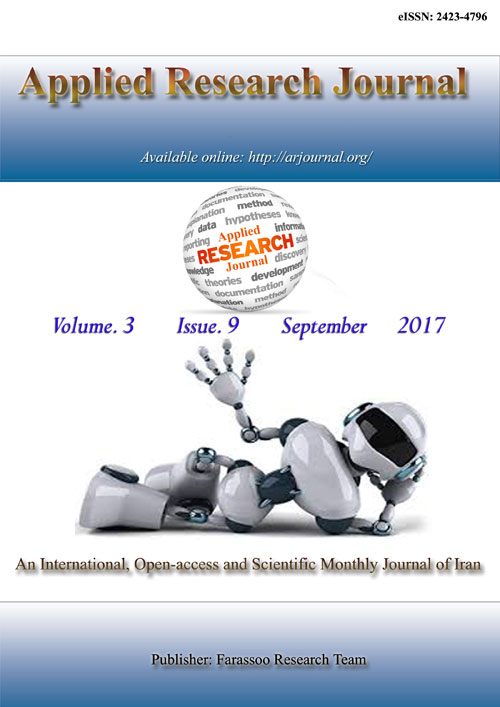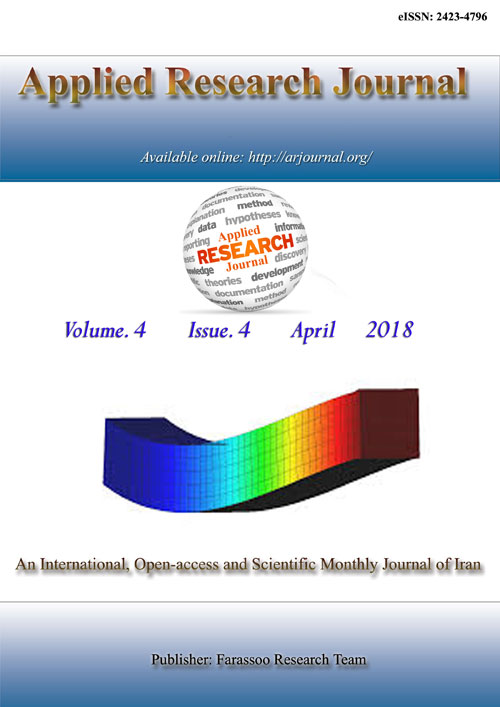فهرست مطالب

Applied Research Journal
Volume:3 Issue: 9, Sep 2017
- تاریخ انتشار: 1396/08/15
- تعداد عناوین: 3
-
Pages 266-270High performance liquid chromatography (HPLC) can be regarded as one of the most usual and widespread separation techniques in different sciences. In this paper, the role of important parameters like chromatography column and the mobile phase on the separation efficiency has been investigated. The modelling and simulation of the separation process of two species was done using finite element method (FEM). Two simulations were done in this work. The first simulation was about the separation of two species with similar concentration and the second simulation was about the separation process of two species with different concentration. The modelling and simulation results showed that the concentration of species has direct relationship with the time of separation and the width and shape of each area are considerably influenced by the migration and movement of analyte in the non-linear domain of absorption isotherm.Keywords: HPLC chromatography, numerical simulation, adsorption isotherm, finite element method
-
Pages 271-285Zeolite membranes NaA, ZSM-5, Mordenite, NaX and NaY grown onto seeded mullite supports. Separation performance of zeolite membranes were studied for water-dimethylhydrazine mixtures using pervaporation (PV). The best Flux and separation factor of the membranes were 0.62 kg/m2.h and 52000, respectively, for NaA zeolite membrane. Strong electrostatic interaction between ionic sites and water molecules (due to its polar nature) makes the zeolite NaA membrane very hydrophilic. Zeolite NaA membranes are thus well suited for separating liquid-phase mixtures by pervaporation. In this study, experiments were conducted with various dimethylhydrazine water mixtures (120 wt. %) at 25 C . Total flux for UDMHwater mixtures was found to vary from 0.331 to 0.241 kg/m2.h with increasing UDMH concentration from 1 to 20 wt.%. Ionic sites of the NaA zeolite matrix play a very important role in water transport through the membrane. Surface diffusion of water occurs in an activated fashion through these sites. A comparison between experimental flux and calculated flux using Stephan Maxwell (S.M.) correlation was made and a linear trend was found to exist for water flux through the membrane with UDMH concentration.Keywords: Nanopore, Pervaporation, Zeolite membranes, Stephan Maxwell model
-
Pages 286-294Hydroxysodalite (HS) Zeolite membrane was prepared onto seeded mullite supports using a new crystallization method called Dry Gel Conversion Technique. Molar composition of the starting gel of HS zeolite membrane was SiO2/Al2O3=1.0, Na2O/Al2O3=65, and H2O/Al2O3=1000. X-ray diffraction (XRD) patterns of the membranes exhibited peaks corresponding to the support and the zeolite. The crystal species were characterized by XRD and morphology of the supports subjected to crystallization was characterized by Scanning electron microscopy (SEM). Separation performance of HS zeolite membranes was studied for water-Ethanol mixtures using pervaporation (PV). The membranes showed good selectivity towards water in the water-Ethanol mixtures. Water permeates faster because of its preferential adsorption into the nano-pores of the hydrophilic zeolite membrane. In PV of water-Ethanol mixtures, the membrane exhibits a hydrophilic behavior, with a high selectivity towards water and a good flux. The best Flux and separation factor of the membranes were 2.05 kg/m2.h and 10000, respectively. In addition, these membranes used for hydrogen separation from CH4 and It shown high selectivity and permeability ratio to zeolite membrane preparated by conventional method.Keywords: Nano, Hydroxysodalite, Pervaporation, Dry gel, Zeolite, Membrane


